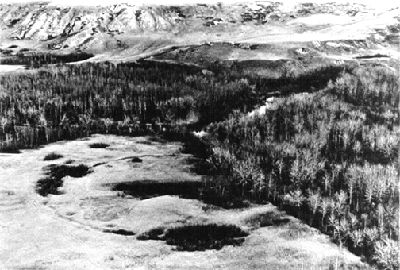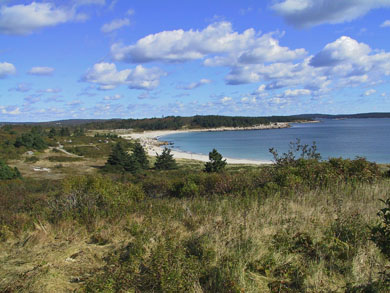Browse "Historic sites"
-
Article
Burgess Shale
Burgess Shale is an area of layered rock featuring fossils from the middle of the Cambrian period (505–510 million years ago). In Canada, sites featuring Burgess Shale fossils are found in Yoho and Kootenay national parks. The name “Burgess” comes from Mount Burgess, a peak in Yoho National Park near where the original Burgess Shale site was discovered (the mountain is in turn named for Alexander Burgess, an early deputy minister of the Department of the Interior). Burgess Shale sites are the clearest record of Cambrian marine life because they contain rare fossils of soft-bodied organisms. The original Burgess Shale site is one of the reasons seven parks in the area were designated the Canadian Rocky Mountains UNESCO World Heritage site (the parks are Yoho, Jasper, Banff and Kootenay national parks, and Mount Robson, Mount Assiniboine and Hamber provincial parks).
"https://d2ttikhf7xbzbs.cloudfront.net/media/media/627px-Charles_Doolittle_Walcott_Excavating_Burgess_Shale.jpg" // resources/views/front/categories/view.blade.php
https://d2ttikhf7xbzbs.cloudfront.net/media/media/627px-Charles_Doolittle_Walcott_Excavating_Burgess_Shale.jpg
-
Article
Camp X
Camp X — a popular name that reflects the secrecy surrounding its activities — was a training school for covert agents and a radio communications centre that operated close to Whitby, Ontario, during the Second World War. It was the first such purpose-built facility constructed in North America. Known officially as STS (Special Training School) 103, Camp X was one of several dozen around the world that served the needs of the Special Operations Executive (SOE), the British agency created in 1940 to “set Europe ablaze” by promoting sabotage and subversion behind enemy lines. The radio communications centre, with its high-speed transmitter known as Hydra, was closely linked with British Security Co-Ordination (BSC), the New York-based agency directed by the Winnipeg-born businessman William Stephenson. Soviet defector Igor Gouzenko was hidden there after his defection in September 1945.
"https://d2ttikhf7xbzbs.cloudfront.net/media/media/29e7f4d4-b408-4532-8c5f-c3aa1874cc0c.jpg" // resources/views/front/categories/view.blade.php
https://d2ttikhf7xbzbs.cloudfront.net/media/media/29e7f4d4-b408-4532-8c5f-c3aa1874cc0c.jpg
-
Article
Kinngait
Kinngait (Cape Dorset), Nunavut, incorporated as a hamlet in 1982, population 1,441 (2016 census), 1,363 (2011 census). The hamlet of Kinngait is situated on Dorset Island, off the southeast coast of the Foxe Peninsula of Baffin Island, 395 km southwest of Iqaluit. Known for a period as Cape Dorset, in 2020 the hamlet returned to its original Inuktut name, Kinngait, meaning “mountains.”
"https://development.thecanadianencyclopedia.ca/images/tce_placeholder.jpg?v=e9dca980c9bdb3aa11e832e7ea94f5d9" // resources/views/front/categories/view.blade.php
https://development.thecanadianencyclopedia.ca/images/tce_placeholder.jpg?v=e9dca980c9bdb3aa11e832e7ea94f5d9
-
Article
Cariboo Road
A contingent of Royal Engineers was brought from Britain to survey the route from Yale, at the head of navigation on the Fraser River, along extremely treacherous terrain to the administrative centre of the Cariboo.
"https://d2ttikhf7xbzbs.cloudfront.net/media/media/59bb3c56-871c-4015-bd1e-85b23dc3f1f4.jpg" // resources/views/front/categories/view.blade.php
https://d2ttikhf7xbzbs.cloudfront.net/media/media/59bb3c56-871c-4015-bd1e-85b23dc3f1f4.jpg
-
Article
Carleton Martello Tower National Historic Site of Canada
Today, Carleton Martello Tower National Historic Site offers visitors a restored barracks room and powder magazine, guided tours, special events, and an award-winning exhibit in its visitor centre. The spectacular panoramic view from its observation level leaves a lasting impression.
"https://d2ttikhf7xbzbs.cloudfront.net/media/media/4963c3ae-2d47-43bb-bb46-f3cb653b9ea7.jpg" // resources/views/front/categories/view.blade.php
https://d2ttikhf7xbzbs.cloudfront.net/media/media/4963c3ae-2d47-43bb-bb46-f3cb653b9ea7.jpg
-
Article
Castle Frank
Castle Frank was a concession of land in the colonial town of York, purchased by John Graves Simcoe in the name of his son, Francis, in 1793. A log house later built on the site also bore the same name. Today the name Castle Frank is preserved as a street, a brook and a station on Toronto’s transit line.
"https://d2ttikhf7xbzbs.cloudfront.net/media/media/88f04fde-a25a-4d14-b736-8d545ff0636c.jpg" // resources/views/front/categories/view.blade.php
https://d2ttikhf7xbzbs.cloudfront.net/media/media/88f04fde-a25a-4d14-b736-8d545ff0636c.jpg
-
Article
Notre-Dame de Québec Cathedral-Basilica
Notre-Dame de Québec is a cathedral-basilica with primatial status, being the mother church of a primate of the Catholic Church in Canada, in this case the Archbishop of Québec.
"https://d2ttikhf7xbzbs.cloudfront.net/media/media/6a73eb44-33c1-41c9-9e6f-4d4f853b2e7e.jpg" // resources/views/front/categories/view.blade.php
https://d2ttikhf7xbzbs.cloudfront.net/media/media/6a73eb44-33c1-41c9-9e6f-4d4f853b2e7e.jpg
-
Article
Château Frontenac
Built by Canadian Pacific beginning in 1892, and designed by architect Bruce Price, the Château Frontenac is an excellent example of château-style hotels developed by railway companies in Canada.
"https://d2ttikhf7xbzbs.cloudfront.net/media/media/7d924fcf-8eec-4819-8503-5b8f85bbd7cb.jpg" // resources/views/front/categories/view.blade.php
https://d2ttikhf7xbzbs.cloudfront.net/media/media/7d924fcf-8eec-4819-8503-5b8f85bbd7cb.jpg
-
Article
Chateau Lake Louise
Chateau Lake Louise is a world-renowned mountain resort and UNESCO World Heritage Site located in Banff National Park, Alberta. Known as the “Diamond in the Wilderness,” the chateau was built beginning in the late 1800s, and was developed as part of the CPR’s network of hotels. It shares a lineage with the Banff Springs Hotel, Le Chateau Frontenac in Québec City and the Empress Hotel in Victoria. Considering its remote location and its eventual scale, the Chateau Lake Louise marked an important point in the development of the Canadian West.
"https://d2ttikhf7xbzbs.cloudfront.net/media/media/fd1b73ac-b324-4388-a19b-a3de2c9da995.jpg" // resources/views/front/categories/view.blade.php
https://d2ttikhf7xbzbs.cloudfront.net/media/media/fd1b73ac-b324-4388-a19b-a3de2c9da995.jpg
-
Article
Cluny Archaeological Site
The Cluny archaeological site is located along the north bank of the Bow River in south-central Alberta.
"https://d2ttikhf7xbzbs.cloudfront.net/media/media/3e3e67a5-aeaa-4856-ac64-d305e5d4be67.jpg" // resources/views/front/categories/view.blade.php
https://d2ttikhf7xbzbs.cloudfront.net/media/media/3e3e67a5-aeaa-4856-ac64-d305e5d4be67.jpg
-
"https://development.thecanadianencyclopedia.ca/images/tce_placeholder.jpg?v=e9dca980c9bdb3aa11e832e7ea94f5d9" // resources/views/front/categories/view.blade.php
https://development.thecanadianencyclopedia.ca/images/tce_placeholder.jpg?v=e9dca980c9bdb3aa11e832e7ea94f5d9
-
Article
Colonial Building
The Colonial Building, in St John's, NL, was declared a provincial historical site by an act of the legislature of Newfoundland in 1974.
"https://d2ttikhf7xbzbs.cloudfront.net/media/media/7ef97226-7c00-45f3-a406-be37c48cf23c.jpg" // resources/views/front/categories/view.blade.php
https://d2ttikhf7xbzbs.cloudfront.net/media/media/7ef97226-7c00-45f3-a406-be37c48cf23c.jpg
-
Article
Commissariat House
Commissariat House is a provincial HISTORIC SITE (designated in1977) located in ST JOHN'S, NL, and is an excellent example of Georgian architecture. Constructed between 1818 and 1820, it was built to house the Commissariat
"https://d2ttikhf7xbzbs.cloudfront.net/media/media/60f97f93-5637-43c2-986f-dc001ec68466.jpg" // resources/views/front/categories/view.blade.php
https://d2ttikhf7xbzbs.cloudfront.net/media/media/60f97f93-5637-43c2-986f-dc001ec68466.jpg
-
Article
Coote Cove Archaeological Site
Coote Cove was once a small but vibrant 19th-century fishing community located on a large headland approximately 35 km from Halifax in Nova Scotia.
"https://d2ttikhf7xbzbs.cloudfront.net/media/media/35433013-7da6-4ad1-9adf-22da509b0c81.jpg" // resources/views/front/categories/view.blade.php
https://d2ttikhf7xbzbs.cloudfront.net/media/media/35433013-7da6-4ad1-9adf-22da509b0c81.jpg
-
Article
Craigflower Manor and Schoolhouse
The Craigflower Manor (1856) and Schoolhouse (1855) were built by the Puget's Sound Agricultural Company, a subsidiary of the Hudson’s Bay Company (HBC). Both the manor and schoolhouse national historic sites located near Victoria, British Columbia.
"https://d2ttikhf7xbzbs.cloudfront.net/Craigflower/Craigflower_Manor_House.jpg" // resources/views/front/categories/view.blade.php
https://d2ttikhf7xbzbs.cloudfront.net/Craigflower/Craigflower_Manor_House.jpg
